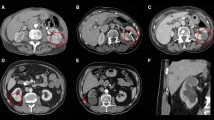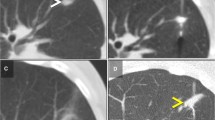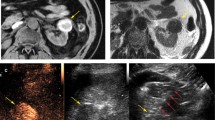Abstract
Purpose
To update the oncologic outcomes and safety for microwave (MW) ablation of T1a (≤4.0 cm) and T1b (4.1–7.0 cm) renal cell carcinoma (RCC) with emphasis on tumor complexity and single session treatment.
Materials and Methods
Retrospective review of 29 consecutive patients (30 tumors) with localized (NOMO) RCC (23 T1a; 7 T1b) treated with percutaneous MW ablation between 3/2013 and 6/2014. Primary outcomes investigated were technical success, local tumor progression (LTP), and complications. Technical success was assessed with contrast-enhanced computed tomography (CECT) immediately after MW ablation. Presence of LTP was assessed with CECT or contrast-enhanced magnetic resonance at 6-month target intervals for the first two years and annually thereafter. Complications were categorized using the Clavien-Dindo classification system.
Results
Median tumor diameter was 2.8 cm [IQR 2.1–3.3] for T1a and 4.7 cm [IQR 4.1–5.7] for T1b tumors. Median RENAL nephrometry score was 7 [IQR 4–8] for T1a tumors and 9 [IQR 6.25–9.75] for T1b tumors. Technical success was achieved for 22 T1a (96%) and 7 T1b (100%) tumors. There were no LTP during a median imaging follow-up of 12.0 months [IQR 6–18] for the 23 patients (24 tumors) with greater than 6 months of follow-up. There were three Clavien-Dindo grade I–II complication (10%) and no Clavien-Dindo grade III–V complications (0%). All but two patients (93%) are alive without metastatic disease; two patients died after 12-month follow-up of causes unrelated to the MW ablation.
Conclusion
Percutaneous MW ablation appears to be a safe and effective treatment option for low, moderate, and highly complex T1a and T1b RCC in early follow-up.



Similar content being viewed by others
References
Campbell SC, et al. (2009) Guideline for management of the clinical T1 renal mass. J Urol 182(4):1271–1279
Atwell TD, et al. (2013) Percutaneous ablation of renal masses measuring 3.0 cm and smaller: comparative local control and complications after radiofrequency ablation and cryoablation. AJR Am J Roentgenol 200(2):461–466
Gervais DA, et al. (2005) Radiofrequency ablation of renal cell carcinoma: part 1, Indications, results, and role in patient management over a 6-year period and ablation of 100 tumors. AJR Am J Roentgenol 185(1):64–71
Zagoria RJ, et al. (2007) Oncologic efficacy of CT-guided percutaneous radiofrequency ablation of renal cell carcinomas. Am J Roentgenol 189(2):429–436
Georgiades CS, Rodriguez R (2014) Efficacy and safety of percutaneous cryoablation for stage 1A/B renal cell carcinoma: results of a prospective, single-arm, 5-year study. Cardiovasc Intervent Radiol 37(6):1494–1499
Goyal J, et al. (2012) Single-center comparative oncologic outcomes of surgical and percutaneous cryoablation for treatment of renal tumors. J Endourol 26(11):1413–1419
Psutka SP, et al. (2013) Long-term oncologic outcomes after radiofrequency ablation for T1 renal cell carcinoma. Eur Urol 63(3):486–492
Thompson RH, et al. (2015) Comparison of partial nephrectomy and percutaneous ablation for cT1 renal masses. Eur Urol 67(2):252–259
Klatte T, et al. (2011) Laparoscopic cryoablation versus partial nephrectomy for the treatment of small renal masses: systematic review and cumulative analysis of observational studies. Eur Urol 60(3):435–443
Atwell TD, et al. (2012) Complications following 573 percutaneous renal radiofrequency and cryoablation procedures. J Vasc Interv Radiol 23(1):48–54
Yu J, et al. (2014) US-guided percutaneous microwave ablation versus open radical nephrectomy for small renal cell carcinoma: intermediate-term results. Radiology 270(3):880–887
Yu J, et al. (2012) US-guided percutaneous microwave ablation of renal cell carcinoma: intermediate-term results. Radiology 263(3):900–908
Moreland AJ, et al. (2014) High-powered microwave ablation of t1a renal cell carcinoma: safety and initial clinical evaluation. J Endourol 28(9):1046–1052
Varkarakis IM, et al. (2005) Percutaneous radio frequency ablation of renal masses: results at a 2-year mean followup. J Urol 174(2):456–460 (discussion 460)
Atwell TD, et al. (2015) Percutaneous cryoablation of stage t1b renal cell carcinoma: technique considerations, safety, and local tumor control. J Vasc Interv Radiol 26(6):792–799
Yu J, et al. (2011) A comparison of microwave ablation and bipolar radiofrequency ablation both with an internally cooled probe: results in ex vivo and in vivo porcine livers. Eur J Radiol 79(1):124–130
Andreano A, Brace CL (2013) A comparison of direct heating during radiofrequency and microwave ablation in ex vivo liver. Cardiovasc Intervent Radiol 36(2):505–511
Laeseke PF, et al. (2009) Microwave ablation versus radiofrequency ablation in the kidney: high-power triaxial antennas create larger ablation zones than similarly sized internally cooled electrodes. J Vasc Interv Radiol 20(9):1224–1229
Li X, et al. (2011) Comparison of microwave ablation and multipolar radiofrequency ablation, both using a pair of internally cooled interstitial applicators: results in ex vivo porcine livers. Int J Hyperthermia 27(3):240–248
Knavel EM, et al. (2012) High-powered gas-cooled microwave ablation: shaft cooling creates an effective stick function without altering the ablation zone. Am J Roentgenol 198(3):W260–W265
Farrell MA, et al. (2003) Paranephric water instillation: a technique to prevent bowel injury during percutaneous renal radiofrequency ablation. Am J Roentgenol 181(5):1315–1317
Campbell C, et al. (2012) Contrast media-doped hydrodissection during thermal ablation: optimizing contrast media concentration for improved visibility on CT images. Am J Roentgenol 199(3):677–682
Charlson ME, et al. (1987) A new method of classifying prognostic comorbidity in longitudinal studies: development and validation. J Chronic Dis 40(5):373–383
Kutikov A, Uzzo RG (2009) The R.E.N.A.L. nephrometry score: a comprehensive standardized system for quantitating renal tumor size, location and depth. J Urol 182(3):844–853
Dindo D, Demartines N, Clavien PA (2004) Classification of surgical complications: a new proposal with evaluation in a cohort of 6336 patients and results of a survey. Ann Surg 240(2):205–213
Ahmed M, et al. (2014) Image-guided tumor ablation: standardization of terminology and reporting criteria—a 10-year update. Radiology 273(1):241–260
Schmit GD, et al. (2013) Usefulness of R.E.N.A.L. nephrometry scoring system for predicting outcomes and complications of percutaneous ablation of 751 renal tumors. J Urol 189(1):30–35
McClure TD, et al. (2014) Intermediate outcomes and predictors of efficacy in the radiofrequency ablation of 100 pathologically proven renal cell carcinomas. J Vasc Interv Radiol 25(11):1682–1688 (quiz 1689)
Camacho JC, et al. (2015) R.E.N.A.L. (Radius, exophytic/endophytic, nearness to collecting system or sinus, anterior/posterior, and location relative to polar lines) nephrometry score predicts early tumor recurrence and complications after percutaneous ablative therapies for renal cell carcinoma: a 5-year experience. J Vasc Interv Radiol 26(5):686–693
Brace CL, et al. (2007) Microwave ablation with multiple simultaneously powered small-gauge triaxial antennas: results from an in vivo swine liver model. Radiology 244(1):151–156
Brace CL (2009) Microwave ablation technology: what every user should know. Curr Probl Diagn Radiol 38(2):61–67
Littrup PJ, et al. (2007) CT-guided percutaneous cryotherapy of renal masses. J Vasc Interv Radiol 18(3):383–392
Schmit GD, et al. (2010) Percutaneous cryoablation of renal masses >or= 3 cm: efficacy and safety in treatment of 108 patients. J Endourol 24(8):1255–1262
Lehman DS, et al. (2008) First prize (tie): laparoscopic renal cryoablation: efficacy and complications for larger renal masses. J Endourol 22(6):1123–1127
Hines-Peralta AU, et al. (2006) Microwave ablation: results with a 2.45-GHz applicator in ex vivo bovine and in vivo porcine liver. Radiology 239(1):94–102
Laeseke PF, et al. (2009) Multiple-antenna microwave ablation: spatially distributing power improves thermal profiles and reduces invasiveness. J Interv Oncol 2(2):65–72
Ziemlewicz TJ, Brace CL, et al. Ultrasound predicts pathologic zone of necrosis better than non-contrast CT during RF and microwave ablation. World Conference on Interventional Oncology Annual Meeting. New York, NY. May 11–14, 2014.
Horn JC, et al. (2014) Percutaneous microwave ablation of renal tumors using a gas-cooled 2.4-GHz probe: technique and initial results. J Vasc Interv Radiol 25(3):448–453
Schmit GD, et al. (2012) Percutaneous cryoablation of solitary sporadic renal cell carcinomas. BJU Int 110(11 Pt B):E526–E531
Woodrum DA, et al. (2010) Role of intraarterial embolization before cryoablation of large renal tumors: a pilot study. J Vasc Interv Radiol 21(6):930–936
Chawla SN, et al. (2006) The natural history of observed enhancing renal masses: meta-analysis and review of the world literature. J Urol 175(2):425–431
Nerli R, et al. (2014) Tumor doubling time of renal cell carcinoma measured by CT. Indian J Urol 30(2):153–157
Jilg CA, et al. (2012) Growth kinetics in von Hippel-Lindau-associated renal cell carcinoma. Urol Int 88(1):71–78
Jewett MA, et al. (2011) Active surveillance of small renal masses: progression patterns of early stage kidney cancer. Eur Urol 60(1):39–44
Author information
Authors and Affiliations
Corresponding author
Ethics declarations
Funding
Neither internal nor external funding was provided for this research.
Conflict of interest
CL Brace is a shareholder and consultant for NeuWave Medical Inc. and Symple Surgical and receives grant support from the National Institute of Health. SA Wells, KM Wheeler, A Mithqal, MS Patel, and NS Schenkman have no potential conflict of interest.
Ethical approval
This study represents a retrospective review of patients who received tumor ablation as a part of clinical care. Tumor ablation is considered an alternative to surgery and is standard of care. Research was not performed on animals in this study.
Informed consent
The study is compliant with the Health Insurance Portability and Accountability Act. The requirement for informed consent was waived.
Rights and permissions
About this article
Cite this article
Wells, S.A., Wheeler, K.M., Mithqal, A. et al. Percutaneous microwave ablation of T1a and T1b renal cell carcinoma: short-term efficacy and complications with emphasis on tumor complexity and single session treatment. Abdom Radiol 41, 1203–1211 (2016). https://doi.org/10.1007/s00261-016-0776-x
Published:
Issue Date:
DOI: https://doi.org/10.1007/s00261-016-0776-x




